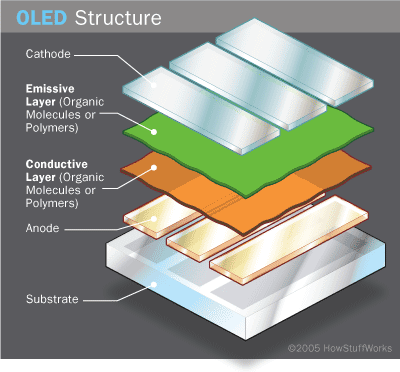Imagine having a high-definition TV that is 80 inches wide and less than a quarter-inch thick, consumes less power than most TVs on the market today and can be rolled up when you're not using it. What if you could have a "heads up" display in your car? How about a display monitor built into your clothing? These devices may be possible in the near future with the help of a technology called organic light-emitting diodes (OLEDs).
OLEDs are solid-state devices composed of thin films of organic molecules that create light with the application ofelectricity. OLEDs can provide brighter, crisper displays on electronic devices and use less power than conventional light-emitting diodes (LEDs) or liquid crystal displays (LCDs) used today.
In this article, you will learn how OLED technology works, what types of OLEDs are possible, how OLEDs compare to other lighting technologies and what problems OLEDs need to overcome.

OLED Components
Like an LED, an OLED is a solid-state semiconductor device that is 100 to 500 nanometers thick or about 200 times smaller than a human hair. OLEDs can have either two layers or three layers of organic material; in the latter design, the third layer helps transport electrons from the cathode to the emissive layer. In this article, we'll be focusing on the two-layer design.
An OLED consists of the following parts:
Substrate (clear plastic, glass, foil) - The substrate supports the OLED.
Anode (transparent) - The anode removes electrons (adds electron "holes") when a current flows through the device.
Organic layers - These layers are made of organic molecules or polymers.
Conducting layer - This layer is made of organic plastic molecules that transport "holes" from the anode. One conducting polymer used in OLEDs is polyaniline.
Emissive layer - This layer is made of organic plastic molecules (different ones from the conducting layer) that transport electrons from the cathode; this is where light is made. One polymer used in the emissive layer is polyfluorene.
Cathode (may or may not be transparent depending on the type of OLED) - The cathode injects electrons when a current flows through the device.
The biggest part of manufacturing OLEDs is applying the organic layers to the substrate. This can be done in three ways:
- Vacuum deposition or vacuum thermal evaporation (VTE) - In a vacuum chamber, the organic molecules are gently heated (evaporated) and allowed to condense as thin films onto cooled substrates. This process is expensive and inefficient.
- Organic vapor phase deposition (OVPD) - In a low-pressure, hot-walled reactor chamber, a carrier gas transports evaporated organic molecules onto cooled substrates, where they condense into thin films. Using a carrier gas increases the efficiency and reduces the cost of making OLEDs.
- Inkjet printing - With inkjet technology, OLEDs are sprayed onto substrates just like inks are sprayed onto paper during printing. Inkjet technology greatly reduces the cost of OLED manufacturing and allows OLEDs to be printed onto very large films for large displays like 80-inch TV screens or electronic billboards.


